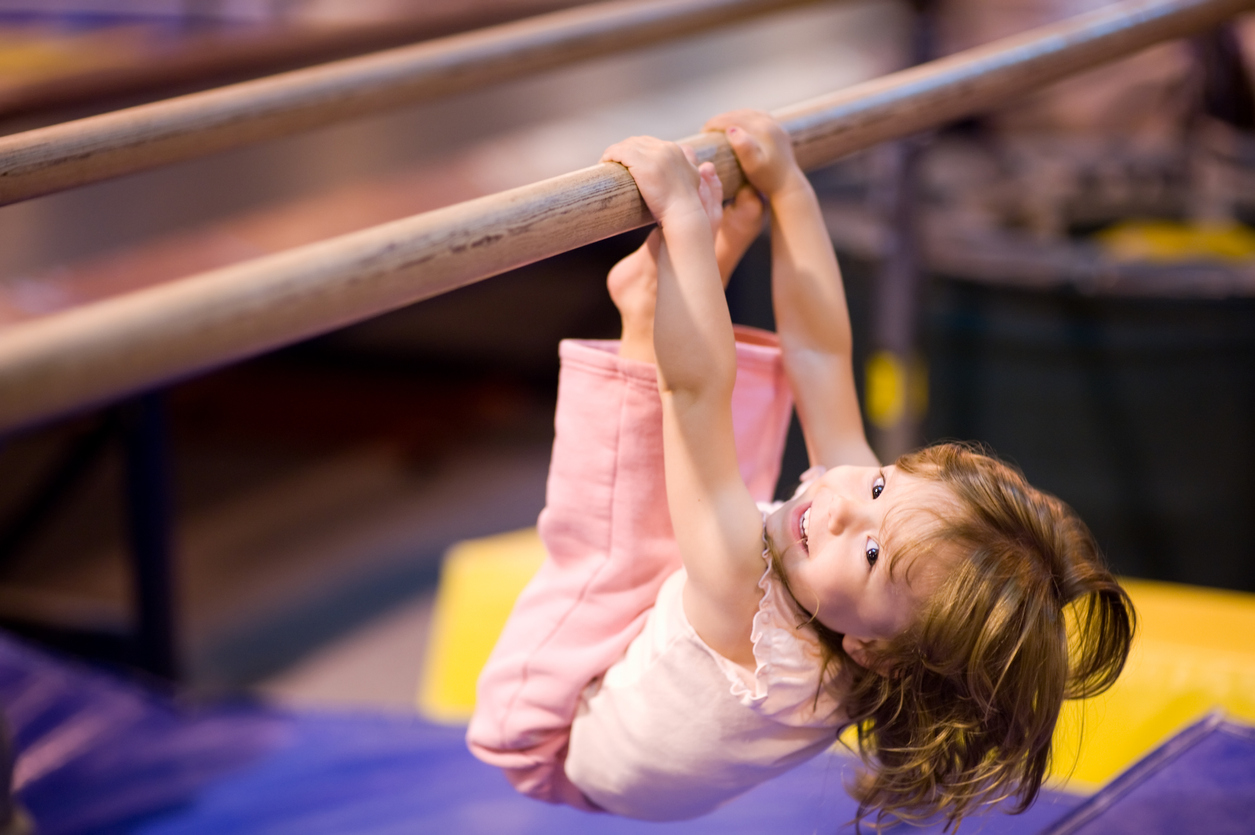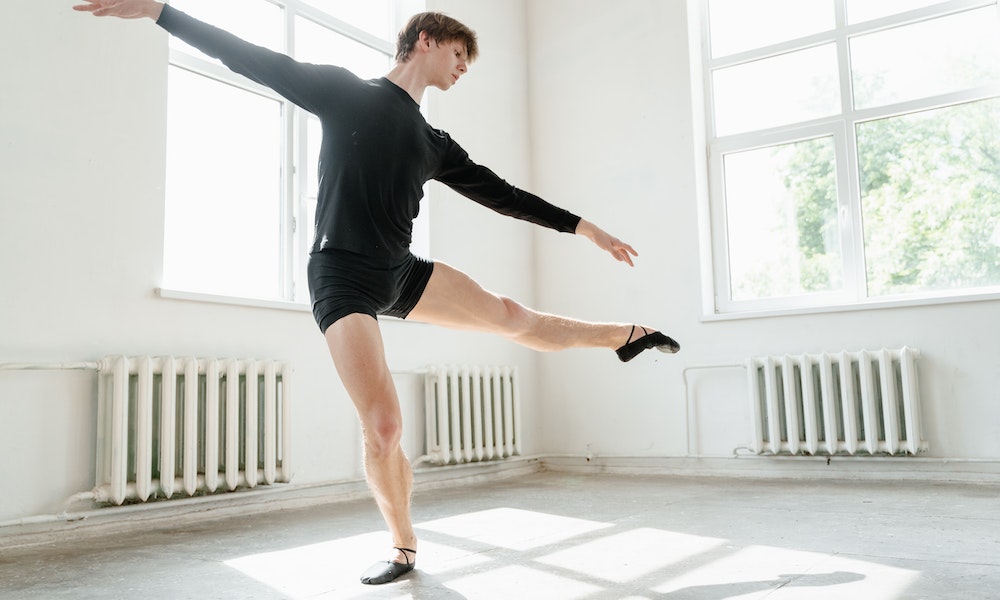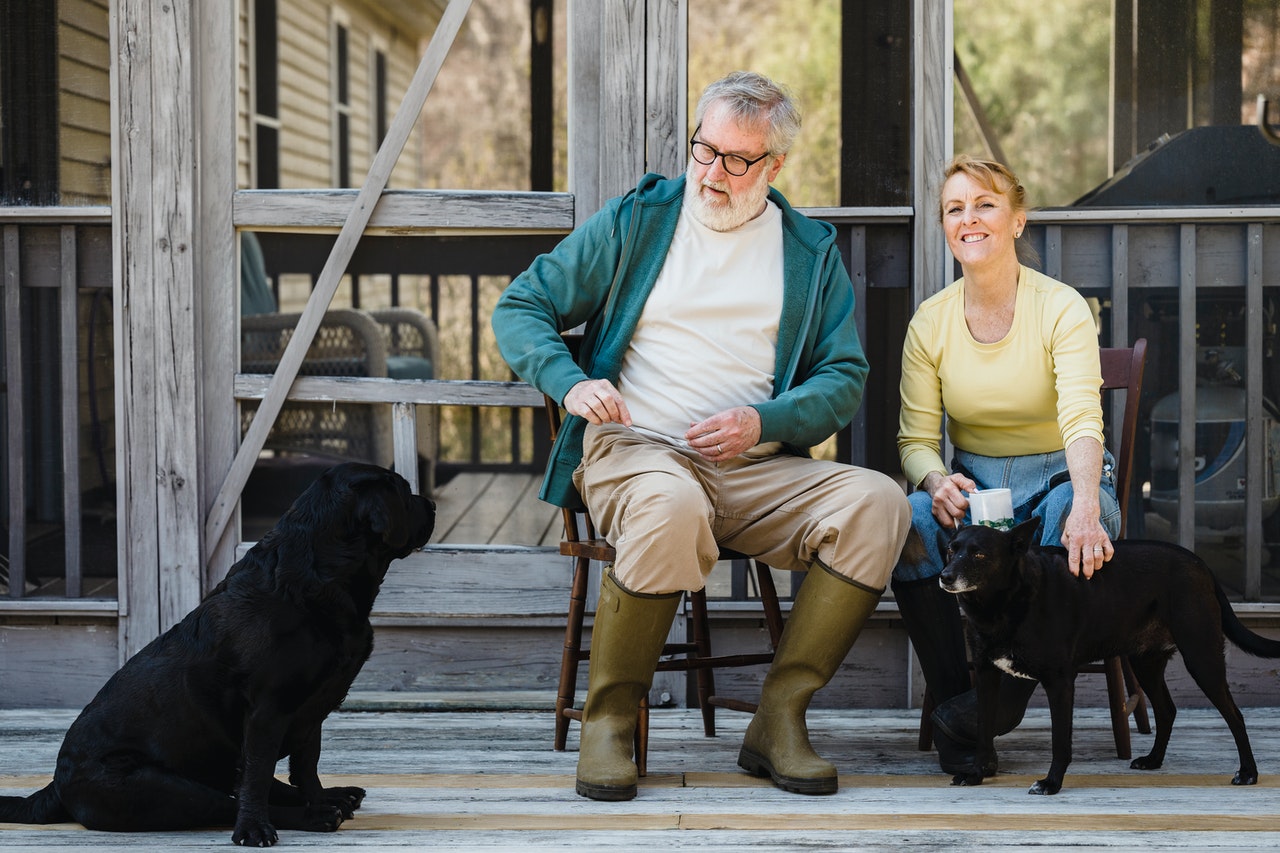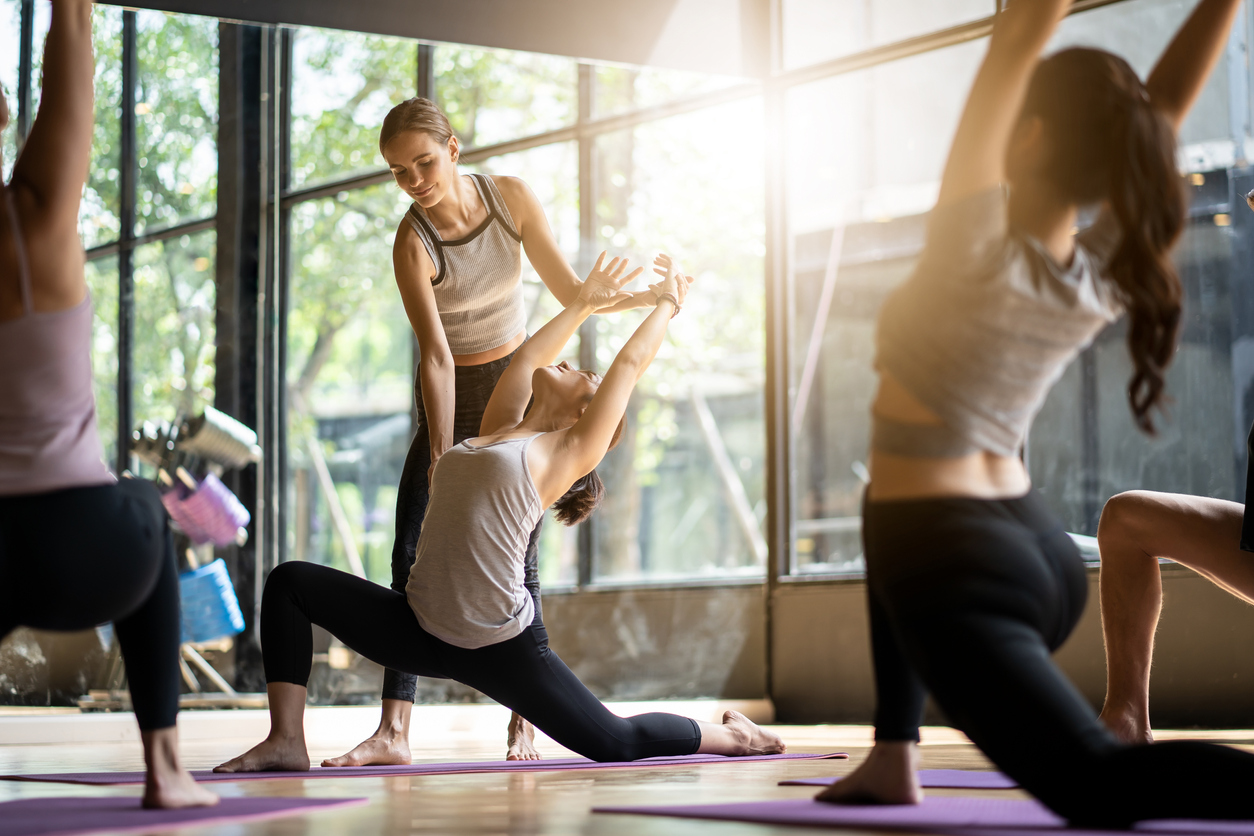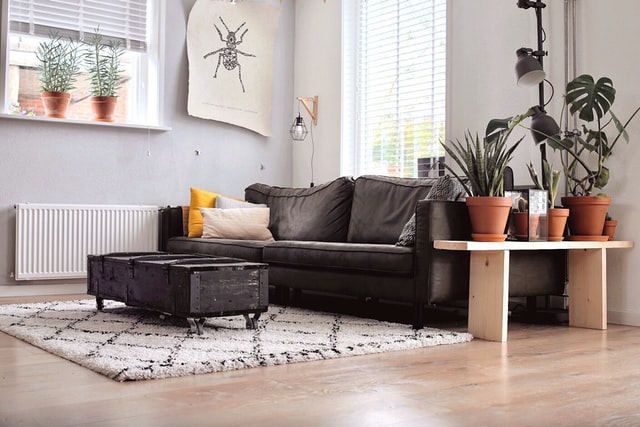Gymnastics is a fantastic way for kids to get physical activity while learning new things and expanding their confidence and social circles. Body awareness is something that children learn as they grow naturally, but you can accelerate that by encouraging them toward gymnastics.
A favorite sport in the Summer Olympic Games, competitive gymnastics is an engaging and fun sport to both watch and compete in. Gymnastics could be a perfect choice if you’re looking for a sport that your little one can grow with.
If you would like to give your kiddo a boost to practicing at home, there are lots of adaptations you can have for this purpose. An at-home practice is an excellent way for beginners to gain confidence before they’re in a group atmosphere, especially if they’re on the shy side.
The Benefits of Gymnastics for Children
Among the many benefits that gymnastics can bring to your child’s life, discipline and soft skills are paramount. Even very young kids, while they may not be spectacular athletes yet, can benefit from learning skills like listening, following directions, and paying attention at a young age. Giving younger children incentive to hone those soft skills by teaching them that it helps them to get better at something they’re interested in, like gymnastics, is a great way to build good habits.
Gymnastics Skills for Young Children
Gymnastics offers myriad skills for your children to hone. Below is an overview of some things you can look forward to developing for your kiddo by doing gymnastics at home.
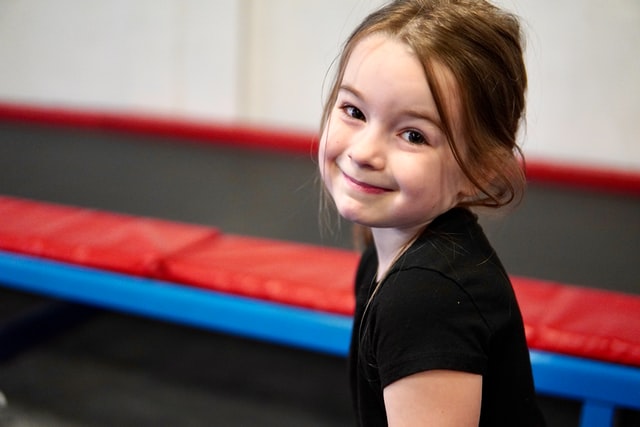
- Gross motor skills – This is a big one that gymnastics helps with. Fine motor skills are learned with things like writing and crafts, but gross motor skills, like hand-eye coordination, require larger spaces and different types of activity to hone.
- Discipline – Once your kiddo is hooked on gymnastics (and if you ask any gymnastics parent, it doesn’t take long), they’ll naturally learn the required discipline to continue learning new gymnastics skills and improving their performance.
- Focus – Getting better at anything takes focus and dedication, and gymnastics is no exception. If your little gymnast wants to develop new skills, their focus will improve along the way, too.
- Strength and flexibility – It’s likely no surprise that gymnasts need crazy amounts of strength and flexibility to perform at their peak and stay healthy. Practicing this sport is an excellent way for your child to improve on both.
- Balance and body awareness – Along with gross motor skills comes the improved ability to balance and be more aware of your body. Gymnasts need high levels of both to be successful and injury-free.
- Following directions and mirroring movements – Like dancers, gymnasts learn through these. Watching their peers, teachers, and competitive athletes is both inspiring and motivating.
Health Benefits of Gymnastics for Kids
Starting gymnastics, or any sport early, has excellent health benefits for kids. Provided they aren’t pushed too hard, resulting in injury or emotional distress, gymnastics is a perfect way to encourage your kids to learn healthy habits early on.
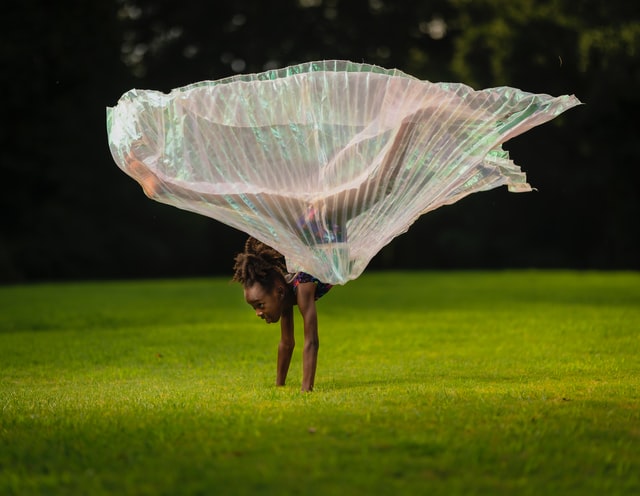
- Improved concentration – The desire to perfect or improve a new skill naturally leads to concentrating on that objective, leading to your kiddo getting better and better concentration.
- Improved motor skills – With practice comes improvement — chances are, as your little one goes along their gymnastics journey, you’ll notice that their motor skills improve. This improvement isn’t only applicable to gymnastics but can also help their performance in other areas.
- Faster learning at school – Neuroplasticity is something that is being discussed more and more. It’s the concept that new activities help build new neural pathways, leading to improved cognitive performance overall. So, don’t be surprised if you find that your child’s academic performance improves as they learn new physical skills.
- Healthy self-esteem – There’s nothing like achieving goals to boost self-esteem, and no matter what level your child is at in gymnastics, setting and celebrating achievable goals is a great way to boost their morale.
- Supports an overall active and healthy lifestyle – Once your kiddo is hooked on gymnastics, they’re likely to seek out ways to be better, and this will very likely include healthy eating and sleeping habits — a win-win!
- Prevents disease – Exercise and physical well-being are known to ward off illness and help our bodies to be healthier overall. Gymnastics is the perfect way to keep your children healthy as a side benefit of doing something they love.
Making Space at Home for Gymnastics
If your youngster is showing an interest in gymnastics, or it’s something you want to encourage them to check out, there are many ways to do it at home so they can get a sense of the sport before signing up for a class. Additionally, if you have a kiddo who’s gymnastics crazy, getting them some key equipment for home is the perfect way to support their development within the sport.
Most of us don’t have the space or resources to set up an entire gymnastics training area at home (if you do, your kiddo is super lucky!). Still, happily, there are individual items that you can purchase so that they can train specific areas at home.
Tumbling mats are an easy-to-store, inexpensive way to give your kiddo a soft surface to practice tumbling and other gymnastics moves. Cheese Wedge mats provide a soft landing for tumbling while conveniently folding up to stay out of the way when they’re not in use.
Tumbling sets offer more of a variety of padded mats, blocks, and shapes to help your little one learn new movements before trying them unassisted.
Padded flooring is an excellent option if you’re considering putting together a more permanent space for gymnastics. Flooring like fit-lock rubber tiles will help your child’s gymnastics practice stay safe and secure.
Air rolls help with stretching, mobility, and practicing body position. Not to mention, your little gymnast will probably love just hanging out on them!
Foam learning beams are a step down from a balance beam, giving your burgeoning gymnast a safe way to practice balance beam moves without the hazard of a potential fall. Foam beams are the perfect starting point.
Balance balls help to build balance and core strength, two critical factors in gymnastics. The bonus is that they deflate for easy storage. Balance balls are just the thing for your home gymnast.
Indoor mini-trampolines help athletes build cardio and leg strength — and bonus for you, they don’t take up too much space or make noise. This option is perfect for conditioning and can be used anywhere in the house.
Outdoor full-size trampolines help to recreate the conditions that a more advanced gymnast will encounter while doing routines, giving beginners a higher margin for error than moving straight off the ground. Trampolines give your gymnast the extra boost they need to level up their gymnastics performance, as long as they’re always supervised to ensure safety.
Most rooms in a home can be altered to create a gymnastics practice space, but as your child’s skills and dedication improve, there are also options to make more significant changes to your home to foster their passion for gymnastics. Adding a room or outdoor space is a great option, if your budget allows, as is having a contractor in to quote the cost of outfitting an existing room more professionally.
Setting Up an Advanced Gymnastics Space
As your gymnastics star progresses in their pursuits, you may want to dedicate more space in your home for their training. While it is quite the commitment, you can outfit their training space incrementally with the following pieces.
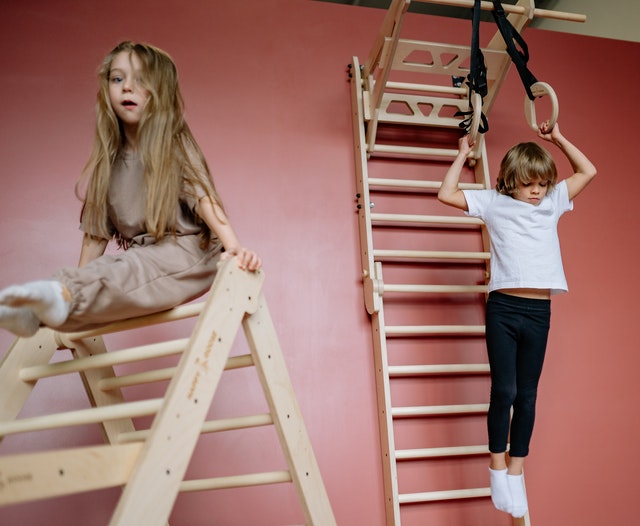
Home gymnastics equipment:
Training bars are essential for gymnasts, helping them improve strength and work on moves they may do at higher heights. Kids pull-up bars are a great addition to your home gymnastics space.
Air tumble mats are great because they can be inflated for use and then deflated for storage, giving your home gymnast versatility.
Tumble tracks are a very useful piece of training equipment, allowing gymnasts to simulate a gym-style environment at home. These are the perfect kinds of tracks to add to your home gymnastics setup.
Vault boards can help your kiddo advance their vaulting skills at home. They are more of an investment and require adequate space to ensure there won’t be any contact with walls, ceilings, or other training gear, but they’re a valuable addition.
Gymnastics rings and straps for skill and strength are as crucial to a solid gymnastics practice as the more specialized equipment. Your gymnast will need to be able to condition and strength train to advance in their sport.
Sticky toes help gymnasts and dancers remember to keep their feet together, which helps with their overall performance and score if they’re competing.
Sliders are discs with one slippery side that goes on the floor and are used under hands, feet, or knees when core conditioning. Sliders are inexpensive and a great addition to your gymnast’s training gear.
Push-up bars can’t be beaten for upper body training. They’re affordable and easy to install.
Yoga mats are a key piece of equipment for floor work. Keeping your gymnasts safe by ensuring they won’t slide out on a slippery floor — it’s an inexpensive addition to their home gym.
Foam rollers are heroes in stretching and working sore muscles, gaining mobility, and rehabbing injuries. Also very reasonable, these will do your gymnast’s body a world of good.
Stall bars are an advanced core piece of equipment, and as your little athlete seeks out new ways of training, these can be a great piece to add to their arsenal.
Chalk is a gymnast’s best friend, preventing sweaty hands from slipping off their equipment. There are many options out there, and it’s easy to find.
Leotards provide gymnasts with modesty and comfort during practices and performances. Good quality leotards are perfect for getting your home gymnast dressed and ready to begin training.
Shoes for gymnasts are a vital piece of their gear if they love beam work. Often also called beam slippers, they’re thin, tightly laced shoes that allow the gymnast to have traction while still feeling the beam beneath them.
Spotting blocks are very important elements as soon as your burgeoning gymnast leaves the ground. They can be placed at different heights and locations to ensure that your gymnast has a safe landing if a move goes off course.
Streamers are used in many gymnastics routines to complement the performance and accentuate the gymnast’s movements. Letting your kiddo experiment with these at home is a great way to introduce them to these fun items.
Protein snack bars provide a quickly digestible boost from protein without adding the bulk of a full meal.
Water bottles are essential since good hydration is key to peak gymnastics performance.
Music is great for motivation and essential for rhythmic gymnastics. Adding a sound system to your at-home gymnastics setup is essential!
Some of the gear we discussed above doesn’t involve a complicated install, but you should put some in with the advice of a knowledgeable professional to ensure that it’s secure and safe for your kiddo.
Safety in The Gymnastics Area

Gymnastics, despite many other excellent benefits, can have the potential for injury if it’s not done safely. There are lots of preventative steps that you can take to make sure injuries don’t occur. We’ll talk about those below.
Your flooring should always be padded and secured down to the floor to avoid trips and falls.
Cork – Cork is potentially an excellent option for flooring, one of the benefits being that it’s a natural, sustainable material.
Foam pits – If you can swing it, putting in a foam pit will give your evolving gymnast a safe place to try new things in a low-risk way.
Wrist straps, guards, and grips – Making sure that this type of protective gear is present and worn is one of the best ways that you can help your kiddo have safe gymnastics practice.
Footwear – What footwear is appropriate will depend on what activity your little one is getting up to. They should always wear beam slippers on the beam, but sturdy cross-trainers are best for strength training with weights.
Spotting belts –A spotting belt is a piece of flexible rubber that the gymnast uses to backstop against a fall or movement that could cause injury. They’re convenient to have around your home gym.
Safe Gymnastics Practices
Following are some excellent best practices to avoid injury when practicing this exciting sport.
- Always warm up and stretch before doing gymnastics. Warming up is, without a doubt, the best way to prevent a needless injury.
- Only practice on padded floors, never on a hard surface. Mats should be placed under the equipment and adequately secured at all times. Even once your kiddo is confident they can do a particular move, all it takes is one slip, and an injury is upon them.
- When jumping into a foam pit, land on feet, bottom, or back; no diving headfirst or landing on the knees. Diving headfirst can easily result in a head or neck injury — not something any gymnast wants!
- No training alone. Always be under the supervision of an adult. This rule can be easy to bend, but it’s crucial, especially if your little gymnast is younger.
- Wear gymnastic clothes that won’t get caught on any equipment. The proper clothing keeps your kiddo safe from being snagged on other equipment, potentially pulling them off course and causing an injury. See leotards above.
- No jewelry. Jewelry is way too easy to get caught on other clothing, equipment or people, and the outcome is never good when it does.
- No gum chewing. After an excellent progress session, the last thing you want is to find a big, sticky wad of gum stuck in your little one’s hair or, worse yet, have them choke on it during practice.
- Stop training if they get hurt or feel pain. Gymnasts must get checked by an athletic trainer, coach, doctor, or nurse before going back to practice. Kids tend to want to push themselves, and ambitious parents can be keen to let them, but remember that your little gymnast needs to stay healthy in order to keep practicing. Set a good example and make sure they stop until a doctor says they’re good to go.
- Play different sports throughout the year to prevent overuse injuries. Cross-training is vital in any sport. Gymnastics is hard on specific parts of our bodies, and taking a break while still doing another athletic activity is a great way to prevent over-use injuries.
- Know the team plan for emergencies. This includes calling 911 for a head, neck, or back injury and NOT moving the injury. Have an emergency plan written down and posted in your child’s practice area. They should know what to do, as should any friends they have over.
Setting up a gymnastics space at home is a wonderful way to allow your kiddo to explore a new sport, learn new things, and improve on skills they already have. With some future thinking and planning, you can build out a great space for your burgeoning gymnast to hone and build new skills and talents!
